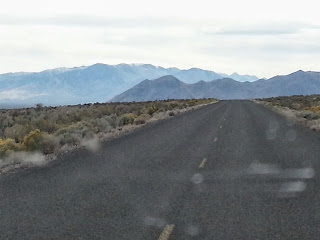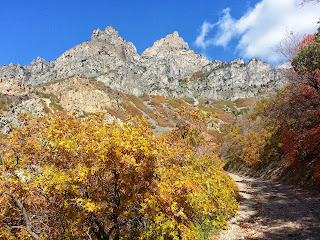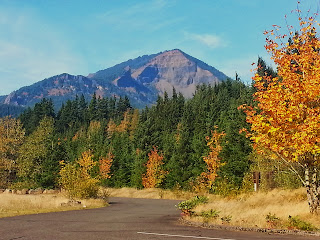Oh my, it got cold, very cold, last night although I am unsure of
exactly how cold but for sure in the low 30"s maybe lower. That portable
alcohol heater sure did its job of keeping my sleeping area warm. In
fact, some time in the night I woke to turn the heater off, only to turn
it back on. This
Origo heater is invaluable. I was so nice and warm I
didn't want to get up. I kept on waiting for the sun, but then realized
by being in a valley it could be some time before the sun's rays hit my
camp.
I warmed up by heating up water for coffee and
instant oatmeal. It was so cold I had to put gloves on. I'm sure my
neighboring campers were amused watching me as they sat in their big
travel trailers all nice and warm. I wished I was too. I wolfed down the
coffee and oatmeal. I then heated up the rest of the coffee to boiling
hot and re-filled my thermos. Camp was easy to break. Move the stuff
from the cab to the back and I was done.
I didn't register
or pay for my campsite last night so Rocky and I took a walk to
register. Then we walked farther along the John Day River on a nice park trail. Several times
we saw deer out feeding. They were probably using the state park as a
refuge to keep from being hunted as it was hunting season. I noticed that it definitely got cold
because there were many places you could see where water in small
puddles, ditches, and ponds had a thin layer of ice. The coffee,
oatmeal, and brisk walk were warming me up. When I left Clyde Holliday
State Park the truck temperature gauge showed a low of 29 F. Okay, it is
officially cold.
After leaving Clyde Holliday State Park
shortly after 8 AM, I entered the small town of John Day. I decided to
get gas because this was the last town of any size until I got to
Winnemucca, Nevada almost 300 miles away. In this distance I only went
through three small towns, if you could call them that. Actually they
really were a collection of a few houses (less than 10), a grade school,
mercantile, and a post office. Lots of vacant buildings which let you
know that sometime in their past they were bigger and more significant
than they are now. The three towns were Frenchglen, Fields, and Denom.
Denom actually straddled the Oregon-Nevada border and was the sorriest
looking of the three. You could tell Frenchglen had some former history
to it and still had a thriving elementary school. Fields seemed to be
more of a hunters destination, although the elementary school seemed
smaller. Perhaps Frenchglen or Fields had gas but it wasn't obvious.
Denom didn't have anything - school, post office, store or bar. In fact,
I wonder considering the shape the town was in, why would anyone choose
to live there.
 |
| Day 2 route is yellow highlighted |
Today's route was, US Highway 26 to the
town of John Day, about 7 miles. Turn right on to US Highway 395 all the
way to just outside of Burns (about 67 miles) to turn off onto OR SR
205, the Frenchglen Highway. Frenchglen being about 60 miles away.
Staying on OR SR 205 for 73 miles until the Oregon-Nevada border where
OR SR 205 became NV SR 292. Three miles down NV SR 292 where it becomes
NV SR 140. Travel 65 miles on NV SR 140 with several very long straight
stretches until it hits US Hwy 95. A right turn onto US 95 and 31 miles
later you're in Winnemucca, Nevada. A left turn onto Interstate 80 and
124 miles later you are in Elko.
 |
| Silvies Ranch country along US 395 heading south |
Between John Day and
Malheur the scenery was typical of the day before. A winding
this-way-that-way road up a canyon until it hit a high point in the
woods. Basalt columnar cliffs and large out croppings of basalt rocks
mixed in with willows along the canyon creek and Ponderosa pines
everywhere else. The Silvies Ranch before I got to Burns, Oregon, seemed
to go on for miles. I noticed that the ranch had several huge barns or
sheds that always featured three evenly spaced characteristic cupolas on
the roof. Also, the gateways to the ranch were stucco arches versus
typical log gateways. US 95 bisected at least 12 or more miles of the
Silvies Ranch.
Just before Burns, US 95 started dropping
out of forested country and into high desert scrub-sagebrush with
steppes and buttes. Malheur Lake was shimmering in the morning sunlight.
I considered stopping at Malheur Wildlife Area but it was closed due to
the government shutdown. Malheur is famous for observing waterfowl. OR
SR 205 bisected the western edge of the Malheur reservoir. I slowed down
but didn't see any waterfowl. What I did have to stop for was a cattle
drive across the road. Now how often does that happen to you? I was
most intrigued how the two Border Collies did all the work to keep the
cattle in line. They wandered this way and that way stopping every now
and then. The cowboys on horseback simply rode along at the cattle's
pace. Wow! Might not seem like much but I found that fascinating and a
most welcome diversion.
 |
| High desert and mountains. (Photo taken through windshield.) |
After Malheur the drive changed
from following along a creek and canyon to driving along the edge of
shallow lakes and wide valleys. A familiar pattern of mountain
range-valley-mountain range became the norm. The road would follow along
or slowly cross a valley, then at some point reach the far mountain
range before going into the next valley and so on and so forth all the
way to Elko, Nevada. Some mountain ranges had big mountains, other
ranges the mountains were simply hills. When you would cross a mountain
range the road would rise sharply and wind its way up and down and over
the range. Driving the valleys consisted of long straight sections with a
slight curve just to keep absolute driving boredom at bay.
Off
to my left as I headed south to Frenchglen was Steens Mountain. This
mountain seems to just rise up out of the steppes. I read that it is its
own ecosystem. I observed plenty of snow up on Steens Mountain. Just
before Frenchglen there even was a skiff of snow alongside the road;
although I was many miles from Steens Mountain. At Frenchglen I saw a
turn off to the "Steens Mountain Loop Road." I decided that traveling
the Steens Mountain Loop Road was on my bucket list.
 |
| SE Oregon on OR SR 205 just outside of Frenchglen |
Right
out of Frenchglen OR SR 205 steeply climbs with many twists and turns
to get out of the valley to get back into that high desert. Once at the
summit the road straightens out back to the familiar boring straights. I
wished I had stopped in Frenchglen but not sure why I didn't. So I will
have to return at some other time.
There was no traffic
until I hit Interstate 80 at Winnemucca. Many times I stopped barely
pulling off
 |
| Sagebrush and empty spaces |
the road to either get a picture or take a pee and for the
whole time - maybe 10-15 minutes there was no other vehicle. I began to
wonder what to do if an unfortunate mechanical issue would arise. You
could get old waiting for another car. When you did stop, it was so
quiet. A few stops had some wind blowing, but I heard no birds or other
critters. I saw a few Marsh Hawks (you can tell by the white rump
patch) and a few Ravens from time to time. I would watch as I drove the
Marsh Hawk hover spying some prey below, but never saw the drop for the
kill. Hmm? The Ravens were always in pairs. Was I missing something? Of
course there were road signs warning drivers to be on the lookout for
wildlife. Oregon had the most boring signs, e.g., Elk, Deer, Livestock,
etc. Nevada's road signage seemed to have action images of cows,
antelope, and deer. Come to think of it, I didn't see any bullet holes
in Nevada road signs whereas Oregon road signs resembled Swiss cheese.
My
traveling of state highways ended when I reached Winnemucca and the end
of Nevada 140 which used to be Oregon 205. From Winnemuca on it was
even more boring high-speed Interstate freeways. I had to put the
pedal-to-the-metal too, from leisurely 55 mph to now blistering
Interstate speed of 75 mph. What's more, from never seeing another
vehicle to now having multiple vehicles - cars, trucks, and semi-tractor
trailer rigs - share the road alongside of you. Wow, I had to stay in
my lane. The only positive was having to share the road with other
vehicles was your only relief from total boredom of driving in Nevada.
All mountains seem to look the same, as well as endless scrub and
sagebrush. I don't remember seeing any trees except those planted around
houses. Uh, not houses but manufactured homes surrounded by multiple
vehicles in various states of disrepair. Used travel trailers (mostly
dilapidated) seemed particularly endemic to the Nevada landscape.
Elko
is kind of an oasis in the middle of a the high desert scrub-sagebrush.
Of course being Nevada there are casinos. Tonight I am moteling it
since the overnight forecast was for temperatures in the 20's. Also,
Rocky and I prefer a comfortable bed versus the bed of a truck if it's
going to get that cold. I pulled into a Motel 6 and got a room for the
night. I don't mind the simplicity of Motel 6, but I like them because
they are pet friendly and cheap. I ate a quick supper then retired. I
was tired, perhaps from driving, perhaps from last night's camping, or
whatever but I didn't stay up too late. It was a good day. Traveled over
430 miles and saw lots of places that I had never been to.





















